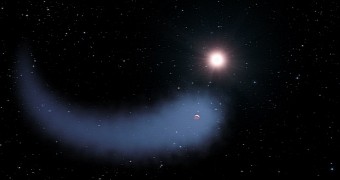A paper published in the science journal Nature earlier this week describes a most peculiar celestial body that, although a planet through and through, looks like a comet.
The orb, dubbed GJ 436b and studied by astronomers with the help of the Hubble Space Telescope, moves around a star located some 30 light-years away from our planet.
It is estimated that the distance between GJ 436b and its parent star is one of about 3 million kilometers (2 million miles). As for its orbit, it looks like a year on this planet lasts merely 2.6 Earth days.
GJ 436b is one seriously weird planet
In their study in the journal Nature, astronomers led by David Ehrenreich of the Observatory of the University of Geneva in Switzerland describe GJ 436b as being about the size of Neptune, whose average diameter is one of 30,598 miles (49,244 kilometers).
What makes the planet one of the weirdest orbs thus far documented by science is the fact that, according to data and images delivered by the Hubble Space Telescope, it has a ginormous cloud trailing behind it as it circles its parent star.
This cloud, nicknamed The Behemoth by astronomers, looks like a comet's tail. It's big enough to cover well over 56% of the surface of the planet's host star and scientists say it's basically an extended atmosphere most likely made up of myriads of hydrogen atoms.
“Astronomers using NASA's Hubble Space Telescope have discovered an immense cloud of hydrogen dubbed ‘The Behemoth’ bleeding off a planet orbiting a nearby star,” reads a report detailing this find.
“The hydrogen is evaporating from a warm, Neptune-sized planet, due to extreme radiation from the star,” University of Geneva astronomer David Ehrenreich and fellow researchers go on to explain.
The planet has lost quite a lot of its atmosphere
Scientists estimate that, since it formed billions of years ago to this day, GJ 436b has lost about 10% of its atmosphere to evaporation. Even so, its doubtful that the planet risks losing all of its atmosphere anytime soon and becoming nothing more than a bare rocky orb.
Astronomers plan to further study the planet in the hope to gain a better understanding of how celestial bodies known as Hot Super-Earths, i.e. orbs stripped of their atmosphere, come into being.

 14 DAY TRIAL //
14 DAY TRIAL //